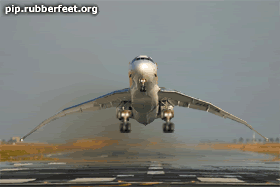Re: Airplane: Does it take off?
The key difference between an airplane and a land vehicle (like a car) is in where the power is being applied.
In a car, the power is applied to the wheels, which push against the ground to move the car forward.
In an airplane taxiing on the ground, the power is applied to the jets (or the propellers), which push against the air.
The airplane's wheels don't do any pushing; they are just passive, un-powered rollers. Their purpose is to keep the plane from falling over, and to make the plane's motion against the ground as frictionless as possible. It's easy to see that a plane's wheels are un-powered if you think about planes designed to land on water (they've got pontoons instead of wheels) or on snow (skis instead of wheels).
So it wouldn't matter if the plane was on a conveyor belt, because whether or not it has traction against the ground isn't important in getting the plane to lift upwards off the ground. What's important is the thrust being applied from the jets or propellers, which pushes against the air, not the ground.
The key difference between an airplane and a land vehicle (like a car) is in where the power is being applied.
In a car, the power is applied to the wheels, which push against the ground to move the car forward.
In an airplane taxiing on the ground, the power is applied to the jets (or the propellers), which push against the air.
The airplane's wheels don't do any pushing; they are just passive, un-powered rollers. Their purpose is to keep the plane from falling over, and to make the plane's motion against the ground as frictionless as possible. It's easy to see that a plane's wheels are un-powered if you think about planes designed to land on water (they've got pontoons instead of wheels) or on snow (skis instead of wheels).
So it wouldn't matter if the plane was on a conveyor belt, because whether or not it has traction against the ground isn't important in getting the plane to lift upwards off the ground. What's important is the thrust being applied from the jets or propellers, which pushes against the air, not the ground.







Comment